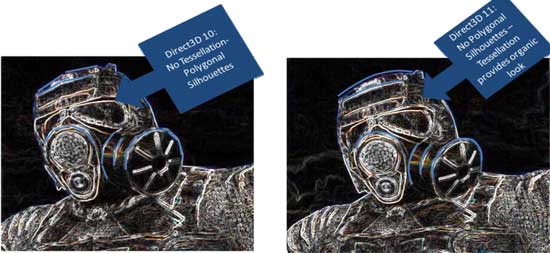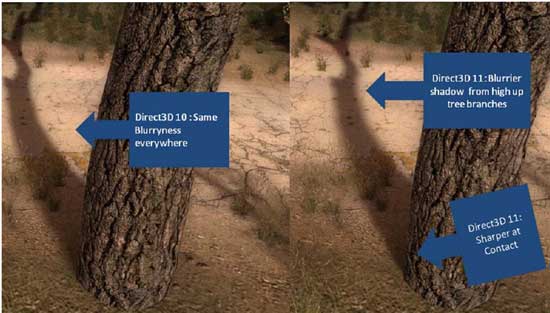The Radeon HD 5970: Completing AMD's Takeover of the High End GPU Market
by Ryan Smith on November 18, 2009 12:00 AM EST- Posted in
- GPUs
STALKER: Call of Pripyat – A Peak at More DX11
For the 5970 launch, AMD sent over a special benchmark version of STALKER: Call of Pripyat, which has since then been made public at the GSC Game World STALKER website. STALKER is another one of AMD’s big DX11 titles, as it’s technically the 2nd DX11 title to launch and the first such title to implement most of the major DX11 features. The Russian version actually shipped back in October, and the German version shipped 2 weeks ago. However we’re told that these versions only had an early-stage implementation of the DX11 feature set, and that the demo is more representative of where the game is after patching and what it will be like when it finally launches in the rest of the world early next year.
Since it’s an unplayable demo, we’re going to forgo any competitive benchmarking (it’s not as if anyone else has a DX11 card anyhow) but we will look quickly at the performance impact of these features, since this is the closest thing we have to a playable game using them at this point in time.
STALKER makes use of 3 major DX11 features.
- High Definition Ambient Occlusion using compute shaders
- Tessellation
- Contact hardening shadows
We’ve already seen HDAO with Battleforge, and it’s no different here in STALKER. And we’ve covered tessellation in-depth in our look at DirectX 11.
So today, let’s talk about contact hardening shadows. Shadowing has been on a path of particularly noticeable evolution. The first real shadows, seen in such titles as Doom 3, had very hard edges. Stencil buffering was used to determine where a shadow would fall, and that was it. Diffusion was never taken into account. Newer games have since taken diffusion into account to generate soft shadows, but these shadows aren’t necessarily accurate. Currently soft shadows are implemented with a fixed degree of softness around the entire shadow, which isn’t how shadows really work.
With diffusion, the softness of a shadow increases with the distance of the casting object from the surface the shadow is being displayed on. AMD loves to use a light pole as an example, as the top of the shadow should be softer than the bottom. These shadows are referred to as contact hardening shadows, and the use of them in games has been limited by the expense of calculating them using the DX10 feature set. STALKER allows for contact hardening shadows with DX10.1 and DX11 mode.
Unfortunately a moving benchmark makes for a poor source to take screenshots, so we’re going to stick with AMD’s reference shots here. Only contact hardening shadows are particularly noticeable in the benchmark; tessellation and HDAO are there, but are virtually impossible to catch given the zoomed-out nature of the benchmark and the fact that it’s constantly in motion.
The benchmark comes with 4 different flybys, each under different environmental conditions: day, night, day with rain, and day with sun shafts. We’ve gone ahead and benchmarked the game during the “day” flyby, once with the DX11 feature set enabled, and once with it disabled. This means for DX11 mode tessellation, contact hardening shadows, and Ultra HDAO were enabled; and for DX10 tessellation and contact hardening shadows were disabled, and High HDAO was used.
| STALKER: Call of Pripyat, Day Benchmark | DX10 | DX11 |
| Average FPS | 31.4 | 35.1 |
| Minimum FPS | 17.7 | 21.2 |
Enabling all of these features actually causes performance to rise, thanks to the more efficient implementation of HDAO as a compute shader as opposed to a pixel shader. Ultimately what this means is that unless HDAO is disabled entirely, STALKER is going to be faster on a DX11 card running the entire DX11 feature set than it will be when running the DX10 feature set.
The biggest performance hit, and the reason we’re not breaking 40fps here even with a 5970, is due to how anti-aliasing is implemented in STALKER. As it uses deferred rendering, the game does its own anti-aliasing. We used 4X MSAA here along with per-pixel alpha transparency testing (basically Adaptive/Transparancy AA). Disabling anti-aliasing improves performance dramatically.













114 Comments
View All Comments
kilkennycat - Thursday, November 19, 2009 - link
Er, have you noticed the "Not in Stock" or "Pre-order" when you have gone to order one. You might get a 5850, but try finding a 5870 without having to psy a jacked-up premium over MSRP. Best of luck.mrdaddyman - Wednesday, November 18, 2009 - link
Since the 5870 seems to be in such great supply, I would like for someone to post a link where I can actually buy one of these. I have been trying to buy one for a month and haven't been able to find one.rennya - Thursday, November 19, 2009 - link
Does it has to be online?Here, I have many options for 58xx and 57xx models in retail stores. Which is more applicable for me because Newegg doesn't ship to my place.
Well, if you insist of finding online links, plenty of them at http://flaturl.com/eb0">http://flaturl.com/eb0 or http://flaturl.com/YmU">http://flaturl.com/YmU or http://flaturl.com/pAU">http://flaturl.com/pAU or http://flaturl.com/q15">http://flaturl.com/q15 or http://flaturl.com/5av">http://flaturl.com/5av and many more.
These are just some of the sellers in my place who sells those so-called mythical ATI cards online (doesn't include the gazillions others sold in retail). You may want to argue that they won't ship to you in United States, but then again the likes of NewEgg doesn't ship here too.
If you are desperate enough, I can help you obtain one of those cards. Want to take the offer?
Alexstarfire - Wednesday, November 18, 2009 - link
And this is the 5970 that we are talking about. Not the same thing.MamiyaOtaru - Thursday, November 19, 2009 - link
by saying "another paper launch" you were implying that the previous launches were paper. So you were talking about the 5870. As they are and have been available, they were not paper launches. So even if the 5970 is a paper launch (it isn't) you can't very well call it another onetajmahal - Wednesday, November 18, 2009 - link
No link yet for the 5850 or the 5870? That's a surprise.lloyd dd - Wednesday, November 18, 2009 - link
would using 3 monitors in portrait orientation sort out the aspect ratio in eyefinity?JarredWalton - Wednesday, November 18, 2009 - link
It would be closer. 4800x2560 would end up at a 1.875 AR, compared to 1.78 for 16:9 and 1.6 for 16:10. I think that 16:9 content stretched to fill 4800x2560 should look fine (about the same as 16:10 stretched to fill a 16:9 monitor).Of course, the more difficult question is how to put three 30" LCDs into portrait mode. You would need a different base stand -- none of the 30" LCDs I've seen allow you to rotate the display into portrait mode, probably because the LCDs are two feet wide.
yyrkoon - Wednesday, November 18, 2009 - link
Hey Jarred,Why not be inventive, and make a stand to hold 3 x 30" LCDs ? I do not mean you specifically of course, but whomever would want to have one. It really is not that difficult . . . just a little planning, and the ability to work with steel ( heavy ) or quality aluminum. Now if someone did not have the skills to make brackets etc, they could even draw something up, give it to a local fabricator, and be on their merry way . . .
Personally, I like the first option mainly because I enjoy working with materials as such ( metals, wood, plastics, etc ). Not to mention the fact that it can cost far less doing it yourself.
JarredWalton - Thursday, November 19, 2009 - link
I understand it's entirely possible. My point is merely that it's yet another expense. I don't think 3x30" with EyeFinity is going to be anything but a very, *VERY* niche product. LOL.5970 = $600
3 x 30" = $3000 (minimum)
3 x Stands = $120 to $600
So besides having the money, you need the space (and possibly time). I'd say $4000+ just for the GPU and LCDs is where the costs start, and naturally you would want a killer system (i7-920 with overclocking, or i7-975). But hey, you want the best of the best, there you have it. Until the next big thing comes along.
Speaking of which, what about 30" LCDs with 120Hz and 3D Vision? LOL.... (No, I'm not saying that's out or coming soon, but it could be.)